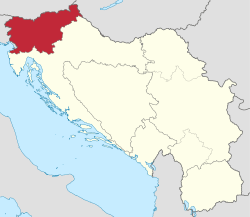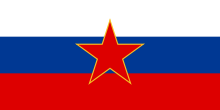Socialist Republic of Slovenia
| Socialist Republic of Slovenia Socialistična republika Slovenija | ||||||
| Constituent republic of Yugoslavia | ||||||
| ||||||
| ||||||
| Anthem Naprej, zastava slave Forward, Flag of Glory | ||||||
 | ||||||
| Capital | Ljubljana | |||||
| Government | Socialist republic | |||||
| Historical era | Cold War | |||||
| • | SNOS | 19 February 1945 | ||||
| • | Referendum | 23 December 1990 | ||||
| • | Independence declared | 25 June 1991 | ||||
| Area | ||||||
| • | 1991 | 20,246 km2 (7,817 sq mi) | ||||
| Population | ||||||
| • | 1991 | 1,913,355 | ||||
| Density | 94.5 /km2 (244.8 /sq mi) | |||||
The Socialist Republic of Slovenia (Slovene: Socialistična republika Slovenija; Serbo-Croatian: Socijalistička Republika Slovenija) was one of the 6 republics forming the post-World War II country of Yugoslavia. It existed under different names from 29 November 1945 until 25 June 1991. In 1990, while the country was still a part of the Yugoslav federation, the League of Communists of Slovenia allowed for the establishment of other political parties, which led to the democratization of the country.[1] The official name of the republic was Federal Slovenia (Federalna Slovenija) until 20 February 1946, when it was renamed to the People's Republic of Slovenia (Ljudska republika Slovenija).[2] It retained this name until 9 April 1963, when it was again renamed, to Socialist Republic of Slovenia.[3] On 8 March 1990, the Socialist Republic of Slovenia removed the prefix "Socialist" from its name, becoming the Republic of Slovenia, though remaining a constituent state of the Socialist Federal Republic of Yugoslavia until 25 June 1991, when it enacted the laws resulting in independence.
Towards independence
In September 1989, numerous constitutional amendments were passed by the Assembly, which introduced parliamentary democracy to the country.[4][5] The same year Action North united both the opposition and democratized communist establishment in Slovenia as the first defense action against Milošević's supporters attacks, leading to Slovenian independence.[6][7][8]
The word 'Socialist' was removed from the name of the then state on 7 March 1990.[9] The socialist infrastructure was largely dissolved. The first open democratic election was held on 8 April 1990.[10] The parliamentary elections were won by the opposition, known as the DEMOS coalition led by the dissident Jože Pučnik. At the same time, Milan Kučan, the former chairman of the League of Communists of Slovenia (ZKS), was elected President of the Republic. The democratically elected parliament nominated the Christian Democratic leader Lojze Peterle as Prime Minister, which effectively ended the 45-year-long rule of the Communist Party. During this period, Slovenia retained its old flag and coat of arms, and most of the previous symbols as it awaited the creation of new symbols that would eventually come after independence. The old national anthem, Naprej zastava slave was however replaced by the Zdravljica already in March 1990.
On 23 December 1990, a referendum on independence was held in Slovenia, at which 94.8% of the voters (88.5% of the overall electorate) voted in favour of secession of Slovenia from Yugoslavia.[11][12] On 25 June 1991, the acts about the Slovenian independence were passed by the Assembly. Following a short Ten-Day War, the military of Slovenia secured its independence; by the end of the year, its independence was recognized by the wider international community.
References
- ↑ "Slovenia". worldstatesmen.org. Retrieved 3 February 2016.
- ↑ Kopač, Janez (2007). "Mesto kot upravnoteritorialna enota 1945–1955" [A Town as an Administrative–Territorial Unit]. Arhivi (in Slovenian and English). Arhivsko društvo Slovenije. 30 (2): 83. ISSN 0351-2835. COBISS 914293.
- ↑ Kopač, Janez (2001). "Ustava Socialistične republike Slovenije z dne 9. aprila 1963" [The Constitution of the Socialist Republic of Slovenia from 9 April 1963]. Arhivi (in Slovenian). XXIV (1): 1.
- ↑ Zajc, Drago (2004). Razvoj parlamentarizma: funkcije sodobnih parlamentov [The Development of Parliamentarism: The Functions of Modern Parliaments] (PDF) (in Slovenian). Publishing House of the Faculty of Social Sciences, University of Ljubljana. p. 109. ISBN 961-235-170-8.
- ↑ "Osamosvojitveni akti Republike Slovenije" [Independence Acts of the Republic of Slovenia] (in Slovenian). Office for Legislation, Government of the Republic of Slovenia. Retrieved 27 December 2011.
- ↑ "Historical Circumstances in Which "The Rally of Truth" in Ljubljana Was Prevented". Journal of Criminal Justice and Security. Retrieved 4 July 2012.
- ↑ ""Rally of truth" (Miting resnice)". A documentary published by RTV Slovenija. Retrieved 4 July 2012.
- ↑ "akcijasever.si". The "North" Veteran Organization. Retrieved 3 July 2012.
- ↑ "Odlok o razglasitvi ustavnih amandmajev k ustave Socialistične Republike Slovenije" [The Decree About the Proclamation of Constitutional Amendments to the Constitution of the Socialist Republic of Slovenia] (PDF). Uradni list Republike Slovenije (in Slovenian). 16 March 1990. Retrieved 27 December 2011.
- ↑ Greif, Gregor (2006). Posledice ustavnih izbir in demokratični prehod v Republiki Sloveniji [The Consequences of Constitutional Choices and the Democratic Transition in the Republic of Slovenia] (PDF) (in Slovenian). Faculty of Social Sciences, University of Ljubljana.
- ↑ Flores Juberías, Carlos (November 2005). "Some legal (and political) considerations about the legal framework for referendum in Montenegro, in the light of European experiences and standards". Legal Aspects for Referendum in Montenegro in the Context of International Law and Practice (PDF). Foundation Open Society Institute, Representative Office Montenegro. p. 74.
- ↑ "Volitve" [Elections]. Statistični letopis 2011 [Statistical Yearbook 2011]. Statistical Yearbook 2011. 15. Statistical Office of the Republic of Slovenia. 2011. p. 108. ISSN 1318-5403.
External links
Coordinates: 46°03′00″N 14°30′00″E / 46.0500°N 14.5000°E


